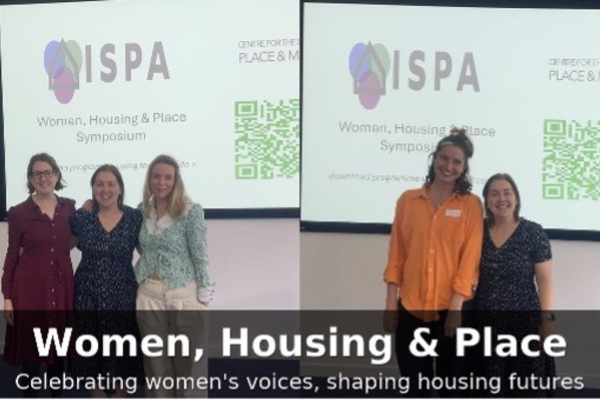At the 2023 HSA conference I presented my research on community-led housing. Focusing on London Community Land Trust I described their development of homes in Mile End and Sydenham using concepts of space, territorialisation and home. While foregrounding the thoughts and experiences of residents, the presentation followed in the phenomenological tradition of treating “life-world experiences as valid knowledge” (Malterud 2012:802). Community land trusts (CLTs) are “democratic, non-profit organisations that own and develop land for the benefit of the community" (CLT Network 2023). Though small, the CLT sector in the UK has been slowly growing since the early 2000s, particularly in rural locations; London CLT was the first to develop in an urban environment.
Territorialisation
Territorology is a way of “conceptualizing the interplay between physical space and the organization of relations and functions that comes along with it” (Brighenti 2010:59). As a theoretical lens, it brings analytical clarity to a sector where much heavy lifting is done by the catch-all term community. Even a leading CLT proponent acknowledges that, while “few words are more familiar in everyday conversation...few are used less precisely”, adding, community is a “rare concept that never has a negative connotation” (Davis 2022:xxx). In contrast, territories build bonds but also establish distance, while territorial boundaries and spatial practice are both inclusive and exclusive. Territories are formed through a convergence of people spreading "reciprocal affections...moods, attitudes, desires, beliefs” (Brighenti 2010:58). They are expressive, including through signs and symbols, and functional – establishing formal relations to institute and maintain territory. All housing estates or localities can be understood as territories, or as multiple territories, but London CLT’s mission statement – “communities creating permanently affordable homes and transforming neighbourhoods” (London CLT 2022) – suggests a particularly conscious form of territorialisation, driven by a set of beliefs and laying the foundation for forms of relations between residents.
London Community Land Trust
London CLT was formed in the lead up to the 2012 Olympics, when The East London Citizens Organisation (TELCO) persuaded the bid team, including the Mayor of London, to commit to a legacy of 2,012 affordable CLT homes on the Olympic Park site. When the bid was won, the organising committee reneged on the agreement, suggesting a pilot elsewhere in the city. Attention turned to St Clements, a former workhouse and psychiatric hospital in Mile End now owned by the Greater London Authority (GLA), that had lain empty since 2005. When the CLT brought St Clements to their attention, the GLA put the site out to tender and though they lost out to a private developer, political pressure from TELCO secured an agreement that 23 of the 230 homes would be sold to London CLT.
With GLA funding and a community share offer, London CLT’s homeownership model was designed to be affordable to those with average incomes for Tower Hamlets, rather than calculated as a percentage of market value. They actually cost around 35% of market value and the same calculation must apply on resales, keeping them permanently affordable. The homes were advertised with five allocation criteria: housing need, five years connection to the Borough, income and affordability, local community involvement, and support for the CLT’s objectives. The last two, a former London CLT Chair explained, were designed,
"to gauge whether the people would be a fit with what we were trying to do in the longer term, which was to develop community" (Former Chair of London CLT).
Territorialising St Clements
In territorialisation terms, London CLT was attempting to spread affects, a belief and an attitude of community involvement and the power of ordinary citizens. As they waited for their new homes to be built, the CLT brought the would-be residents together, through social occasions and community building. Capturing the mood the CLT hoped to spread, Alice1 told me, “the great thing about the whole CLT experience is from the moment we started going to information evenings...we started to build relationships”. Joanna said, “I felt like I moved in with my friends really...with your community...and it continues…”. However, Nathalie found the community building events “a bit infantilising” with their “happy summer camp approach”, while Ella, reflecting a need to establish distance, said, "I haven't been involved in the CLT in the ways that I thought I would, or said I would because I'm just a bit exhausted”.
The CLT homes are spread across the development, but where homes are clustered, they have helped spread affects of conviviality and neighbourliness. Gabriel told me how residents there have expanded their territory, adopting a green space as an extension of their homes:
“especially when the weather's nice...you can just go out and have a drink or coffee and invite friends, or then you see your neighbours, the kids, because they have small kids, they'll be out playing, so that will be our...communal space”.
Sophia added that, “we see people on the street level, whether they’re CLT or not...we know all our neighbours”. However, distancing is also evident at St Clements, with Lisa saying that:
"I prefer to stand back a while before I jump in...it just gives me time to kind of work out whether people are being genuine or not...to kind of step away if you felt like something wasn't quite what you needed".
Expressive aspects of territory include the adoption of oranges and lemons as community symbols, summer picnics and annual St Clements day celebrations, while the functional Resident Management Company (RMC) has been frustrated by the developers’ delayed completion and their subsequent maintenance of control through their own property management agents.
While this may have helped galvanise residents from different tenures to fight a common enemy (there are several concerns about elements of site quality and management) it has left little energy for collectively working out how people can best live together across the development. Martin, though, looked forward to how the RMC might "set an example of good government, with a small 'g'...even disagreeing, like, do we find a good way of disagreeing?". However, James has noticed enthusiasm for the project has waned, not helped by the impact of the Covid-19 pandemic, and that while he tries to ”help out...because it‘s the right thing to do, other people seem to do less and less”. Ben understands the importance of the RMC but says he’s “stretched to breaking point in my own work right now...While I think I could contribute and add to it, I can't”.
On inclusion, in a Borough that has seen rapid gentrification, the CLT homes have established a territory in which a few ‘lottery winners’, as several residents called themselves, have been able to retain their place in the City. Nathalie said that "It utterly transformed our life… we have our own home, which is big enough, in the place that we set down roots twenty years ago, with, you know, a park, Cemetery Park down there, green space over there, the canal there, you know, the schools, the friends, the neighbours...”. However, Lisa, though happy that she has been able to re-establish roots in an area she has lived in since she was a child has concerns: “I don't believe it's, kind of, really for people who are working-class that come from here, because you're not doing any outreach to any of them”. Territorial boundaries also include and exclude and while London CLT’s mission includes ‘transforming neighbourhoods’, it is unclear what impact residents might have outside of their own enclave. Even within, CLT members express concerns about the inferior design of the social housing properties at St Clements and that tenants may feel excluded from the functional and expressive community building efforts.
Bringing it all back home – Rhythms, melodies and themes
First and foremost, London CLTs involvement in St Clements has provided a home for the 23 households. Richardson (2019) lists six key components that make housing home: affordability, quality, security, safety, privacy and connectedness. It is the balance between these last two, privacy and connectedness that will go a long way to determine the nature of the territory at St Clements. Brighenti writes that:
“The relationship between territory and its world is expressed through a specific rhythm and melody possessed by territory. More precisely, the expressive qualities of territory combine among themselves to create certain themes” (Brighenti 2010:64).
The most striking themes from my research at St Clements are of the importance of finding somewhere to call home that is affordable and of good quality, including access to outdoor space and local amenities. The homes provide long-term security and a chance to plan for the future – four of the residents that I interviewed have had their first child since moving in. They allow people to maintain the rhythms of existing connectivity while making new ones. Residents talk most enthusiastically about the expressive aspects, resulting in a sense of conviviality, while most also recognise a need, or an urge to distance – some from time-to-time but others more permanently. There are frustrations, particularly with the developers and managing agents and a recognition that inner-city life and sharing space brings challenges as well as benefits. While these emphasise how the value of home and privacy are held in delicate balance with connectivity to the outside, what the interviews with residents also demonstrate is how the rhythms of everyday life can often be incompatible with the rhythms of active community involvement.
Citizens House
In January 2023, residents began moving into London CLT’s second project and their first self-built properties – the expressively named Citizens House in Sydenham, South-east London. As a self-contained block of 12 CLT flats, residents are getting to know each other, finding out how they want to live together before thinking about longer term management of the area. Although they have ambitions to reach, connect and spread a CLT sense of community to the wider neighbourhood, they recognise their initial focus should be on themselves as a group. It will be interesting to see what rhythms, melodies and themes emerge from Citizens House.
1. All interviewee names have been replaced with pseudonyms.
References
Brighenti, A. M., 2010. On Territorology: Towards a General Science of Territory. Theory, Culture & Society, 27(1), 52–72. https://doi.org/10.1177/0263276409350357
CLT Network, 2023. State of the Community Land Trust Sector 2023 [online] Available at: https://www.communitylandtrusts.org.uk/news-and-events/new-research-shows-potential-for-278000-more-community-led-homes/
London Community Land Trust, 2022. Annual Report 2021-2022. London: London CLT
Malterud, K., 2012. Systematic text condensation: a strategy for qualitative analysis. Scand J Public Health. 2012 Dec;40(8):795-805. doi: 10.1177/1403494812465030. PMID: 23221918.
Richardson, J., 2019. Place and identity: the performance of home. Oxon: Routledge

Robert Read is a final year PhD student at Anglia Ruskin University researching community-led housing, space and territorialisation. After a thirty-year career in local government and housing, in London and Norfolk, Robert studied for a Masters in Sociology, writing a dissertation on social housing and stigma. His current research explores different typologies of community-led housing in London and East Anglia and Robert has also been working with London Community Land Trust on a research project funded by Guy’s and St Thomas’ Foundation Trust on connections between CLTs and urban health.






